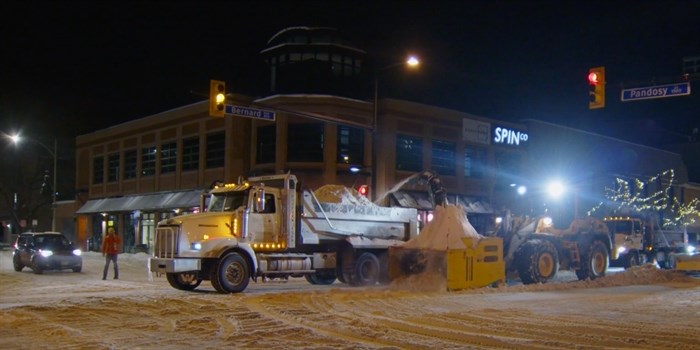
Snowblowers and dump trucks are used to remove snow from downtown Kelowna streets.
Image Credit: Submitted/City of Kelowna
January 11, 2022 - 6:30 AM
In what Geert Bos jokingly refers to as the “eternal debate of salt,” the reality is that, so far this winter, sand has been the tool of choice on city roads.
“We went through the sand shed three times already and it’s only half-January,” Bos, the City of Kelowna’s public works manager, told iNFOnews.ca.
The shed holds 3,600 tonnes of sand. In a normal year it’s filled four times or about 14,000 tonnes are used but so far this year almost 11,000 tonnes have been spread on city streets.
“The city does use salt but we’re very specific with where we use it,” Bos said. “That’s because, when you put salt on snow it melts and when it melts it creates water and when you get water, undoubtedly, you’re going to get ice again.”
The only way around that is to use increasing large amounts of salt, which is expensive and bad for the environment.
In contrast to the 14,000 tonnes a year of sand, the city has averaged just under 2,200 tonnes of salt each year for the past decade.
The city also has about 200,000 litres of calcium chloride on hand but has only used 20,000 to 30,000 litres so far this year, Bos said.
Calcium chloride is a de-icer, which has a salt component, that is sprayed on bare pavement to help prevent the snow from adhering to the asphalt so it can be more easily scraped off by snowplows.
There’s quite a science to when it’s used, Bos said. If precipitation falls as rain that turns to snow that could mean the calcium chloride is washed away before the snow falls so the time, effort and money used to apply it would be wasted.
“There are certain atmospheric conditions where, if there’s a certain level of moisture in the air, when you have de-icing fluid out, it can actually flash freeze the moisture in the air to the surface,“ Bos said. “So now, actually, you’ve created a skating rink.”
It’s used more when there are freeze-thaw cycles.
Actual road salt works best when temperatures are no lower than -3 Celsius at night with daytime highs of 0 C.
Colder than -7 C to -9 C means there’s not enough salt to keep the snow melted unless copious amounts are used.
Even so, salt is only used in select locations.
“It’s used where there’s a lot of walking – so the downtown area, for example – and a lot of intersections where you’re going to see pedestrians mixed with vehicular traffic,” Bos said. “That’s where we like to put down salt and get basically down to the bare pavement.”
Along with and after the December deep freeze there was a series of snowfalls that got city crews behind on plowing, especially on side streets.
READ MORE: Why Kelowna is still catching up on snow clearance
They’re catching up but there will be an overnight parking ban downtown until Thursday morning so snow can be hauled away.
Once they have time, city crews start at the sidewalks and push the snow into the middle of the streets. Then huge snowblowers fling it into dump trucks, filling one in just 45 seconds, so it can be hauled away to melt elsewhere. At the same time, plows are trying to get down to bare pavement. Traffic does a good job of clearing the snow away but city crews will try to get slush removed before it freezes solid.
There may be some de-icing fluid laid down tonight, Jan. 10, in anticipation of the next snowfall tomorrow where two to four centimetres are possible.
The city has 1,800 lane-kilometres of roads it plows using 24 trucks, three graders and eight sidewalk units. They also have access to half-a-dozen contractors to help in busy times, like the last few weeks.
To contact a reporter for this story, email Rob Munro or call 250-808-0143 or email the editor. You can also submit photos, videos or news tips to the newsroom and be entered to win a monthly prize draw.
We welcome your comments and opinions on our stories but play nice. We won't censor or delete comments unless they contain off-topic statements or links, unnecessary vulgarity, false facts, spam or obviously fake profiles. If you have any concerns about what you see in comments, email the editor in the link above.
News from © iNFOnews, 2022